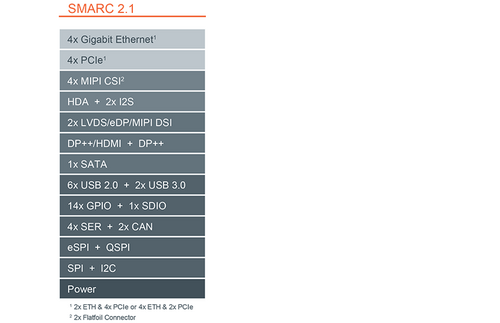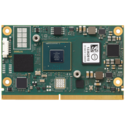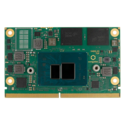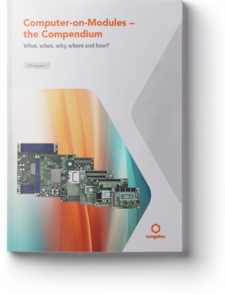
SMARC MODULE - THE HIGH-PERFORMANCE LOW POWER STANDARD
Ideal solution for size, weight, power and
cost-optimized AI applications
SMARC module – credit-card-sized Computer-on-Modules
Perfect solution for size, weight, power and cost-optimized AI applications at the rugged edge
High-performance ecosystem for SWaP-C applications
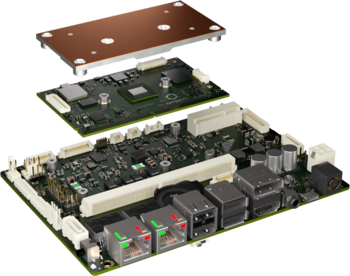
SMARC has been developed to support low-power Arm and x86 processors alike. With its rugged and cost-optimized MXM 3 connector, which is backed by broad industry support due to its use with notebook graphics cards, this module standard enables exceptionally slim and rugged designs.
Highest interface-per-watt ratio of all COM standards
SMARC takes an absolute top position among all Computer-on-Module standards thanks to its unique interface-per-watt-ratio. With a power consumption of typically 6 Watts and 314 signal pins, SMARC module executes up to as many as 4 camera inputs and 4 graphics outputs, making the standard an ideal fit for every embedded vision and situational awareness application. Additionally providing up to 4x Gbit Ethernet ports including support of hardware-based IEEE 1588 precision time protocol (PTP) and the ability to host wireless interfaces like WLAN and Bluetooth on the module, SMARC offers exceptional connectivity for any IoT application. And thanks to CAN bus support, SMARC is also well prepared for in-vehicle applications.
Facts, features and benefits of SMARC module
| Facts | Features | Benefits |
| Vendor independent standard | SMARC modules are available from many different vendors, all exchangeable within the same pin-out and footprint | Increased availability and reliable multi-sourcing strategy reduce cost, improve production scalability, and boost resilience against supply chain issues |
| Processor and SoC agnostic | SMARC modules can host low-power x86 as well as powerful Arm SoCs from different vendors | SMARC modules can host low-power x86 as well as powerful Arm SoCs from different vendors |
| Support of embedded vision and IoT centric interface technology | SMARC modules support up to 4x camera inputs and 4x GbE with TSN as well as optional wireless communication | Future-oriented interface technology for an extra-long application lifecycle without bottlenecks in data transfer rates |
| Reliable connector technology | SMARC modules feature the common MXM 3.0 connector designed for dedicated graphics cards in notebooks | The 314 pin connector features a highly proven technology with a broad supporter base and cost-optimized market offerings for highest reliability and cost efficiency |
SMARC module positioning
SMARC 2.1 is perfectly positioned between the two well-established module standards Qseven and COM Express. Compared with the Qseven standard, SMARC offers more interfaces – especially embedded vision-oriented ports. Compared with the high-performance COM Express or even COM-HPC modules that make up the COM power class, SMARC 2.1 targets low-power applications that cannot be addressed by these performance-oriented standards with way higher power requirements.

| SMARC 2.1 module | Qseven | COM Express 3.1 Type 10 (Mini) | COM-HPC Mini | |
| Footprint | 82x50 mm | 70x70 mm | 40x70 mm (µQseven) | 84x55 mm | 95 x 70 mm |
| Construction height | 1.5 mm (module bottom to carrier board top) | 5 mm (module bottom to carrier board top) | 5 or 10 mm (module bottom to carrier board top) | 5 or 10mm (module bottom to Carrier Board top) |
| Power | 25 W | 12 W | 68 W | 76 W |
| Signal pins | 314 | 230 | 220 | 400 |
| PCIe¹ | 4x PCIe Gen 3 | 4x PCIe Gen 3 | 4x PCIe Gen 4 | 16 x PCIe Gen 5 |
| Graphics¹ | DP++/HDMI + 1x DP++ + 2x LVDS/eDP/MIPI DSI | eDP/HDMI + 2x LVDS | 1x DDI +1 LVDS/eDP | 3x DDi + 1x eDP |
| Sound | HDA + I2S | 1x HDA/I2S | 1x HDA/SoundWire | HDA, Soundwire, & I2S |
| Camera in¹ | 2x MIPI CSI + 2x MIPI CSI (connectors on module) | - | 2x MIPI CSI (connectors on module) | 2x MIPI CSI (connectors on module) |
| Ethernet¹ | 4x 1 GbE with TSN | 1x 1 GbE with TSN | 1x 1 GbE with TSN | 2x 10 GbitE with TSN + 2x 10 GbitE (SERDES) with TSN |
| Wireless | Antenna connector for WiFI & Bluetooth | Not supported | Not supported | Not supported |
| USB¹ | 2x USB 3.0 + 6x USB 2.0 | 2x USB 3.0 + 8x USB 2.0 | 2x USB 3.2 + 8x USB 2.0 | 4x USB 4.0, 4x USB 3.2 x1 / USB 3.2 x1 + 8x USB 2.0 |
| SATA¹ | 1x SATA Gen 3 | 2x SATA Gen 3 | 2x SATA Gen 3 | 2x SATA Gen 3 |
| CAN | 2x | 1x | 2x | 1x |
| UART | 4x | 1x | - | 2x |
| GPIO | 14x | 8x | 8x | 12x |
| Other | eSPI, SPI, I2C | SPI, LPC, I2C, SDI | LPC/eSPI | eSPI, 2x SPI, SMB, 2x I2C |
¹ Not all I/Os are available in parallel. Some pins are shared.
The SMARC ecosystem
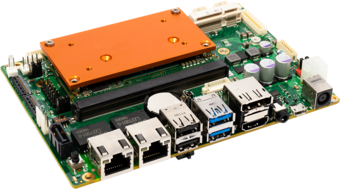
congatec offers a comprehensive SMARC ecosystem allowing agile and reliable realization of future-oriented vision-based AI applications. OEMs get direct access to modules with suitable cooling solutions, carrier boards, and ready-to-go embedded vision starter sets.
conga-SA8
- Intel Atom x7000RE Series
- Up to 8 Cores
- Up to 16 GByte soldered LPDDR5
- Industrial temperature support
- Virtualization ready with Hypervisor

conga-SMC1 3.5-inch carrier board
The size-optimized SMARC 2.1 carrier board in 3.5-inch form factor is application-ready and can be deployed off-the-shelf in small to mid-sized series in combination with any congatec SMARC Computer-on-Module. Tailored to make 3.5-inch SBC designs modular, it is available in optimized x86 and Arm variants. Its slot for SMARC 2.1 processor modules provides processor socket independent scalability, making OEM solutions highly flexible and long term available. The carrier board is also prepared for rapid customizations for best time to market.
Embedded vision starter set
At the heart of the starter set is the SMARC 2.1 Computer-on-Module conga-SMX8-Plus. The 3.5-inch carrier board conga-SMC1/SMARC-ARM directly connects the 13 MP Basler dart daA4200-30mci BCON for MIPI camera without any additional converter modules. Next to MIPI CSI-2.0, USB and GigE vision cameras are also supported. On the software side the set comes with a bootable SD card with preconfigured boot loader, Yocto OS image, matching BSPs, and processor-optimized Basler embedded vision software enabling immediate AI inference training on the basis of captured images and video sequences.
Design-in training Arm
Our Arm design training program provides a sound entry into the complex Arm world by introducing the Arm architecture, special bootloader requirements, and different Operating Systems including Yocto Project and Android. Hands-on training for setting up the hardware, booting a sample image, and BSP setup as well as a presentation of our Technical Service Center (TSC) and its services round off this 3-hour online training program.
Register
Carrier board design-in training
Our carrier board design training program shares best practice knowledge on how to design-in SMARC modules. The courses guide engineers through all the mandatory and recommended design essentials and best practice carrier board schematics. OEMs participating in the program will be able to efficiently simplify their carrier board design projects.

NPU-Accelerated Edge Vision
Embedded vision integration is critical to the success of AI-enabled systems, whether in AMRs, AGVs, quality inspection systems, or collaborative robotics. Preconfigured embedded hardware and software vision building blocks make it easy for developers to quickly create custom solutions.




